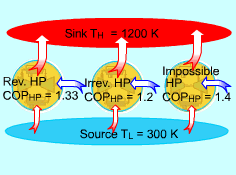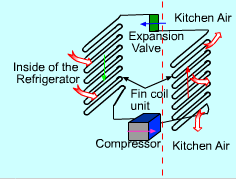| Ch 5. Second Law of Thermodynamics | Multimedia Engineering Thermodynamics | ||||||
| Heat Engine |
The Second Law |
Carnot Cycle |
Carnot Heat Engine |
Carnot Refrigerator |
|||
| Carnot Refrigerator and Heat Pump | Case Intro | Theory | Case Solution |
| Chapter |
| 1. Basics |
| 2. Pure Substances |
| 3. First Law |
| 4. Energy Analysis |
| 5. Second Law |
| 6. Entropy |
| 7. Exergy Analysis |
| 8. Gas Power Cyc |
| 9. Brayton Cycle |
| 10. Rankine Cycle |
| Appendix |
| Basic Math |
| Units |
| Thermo Tables |
| Search |
| eBooks |
| Dynamics |
| Fluids |
| Math |
| Mechanics |
| Statics |
| Thermodynamics |
| Author(s): |
| Meirong Huang |
| Kurt Gramoll |
| ©Kurt Gramoll |
| |
||||||||||||||||
| The Reversed Carnot Cycle
|
 P-v Diagram of the Reversed Carnot Cycle |
The Carnot cycle is a totally reversible cycle. The Carnot refrigeration cycle can be achieved if one reverses all the processes in the Carnot power cycle. In this case, heat in the amount of QL is received by the gas from a heat sink and heat in the amount of QH is rejected to a heat source, and a work input of Wnet,in is required to accomplish the cycle. The P-v diagram of the reversed Carnot cycle is shown on the left. |
||||||||||||||
| The Carnot Refrigerator and Heat Pump
|
||||||||||||||||
A refrigerator or a heat pump that operates on the reversed Carnot cycle is called a Carnot refrigerator or a Carnot heat pump. The coefficient of performance(COP) of reversible or irreversible refrigerator or heat pump is given by COPR = 1/((QH/QL)-1) COPHP = 1/(1-(QL/QH)) where For reversible refrigerators or heat pumps, such as Carnot refrigerators, or Carnot heat pumps, the COPs can be determined by replacing the heat transfer ratios in the above equations by the absolute temperature ratios. These are, COPR,rev = 1/((TH/TL)-1) COPHP,rev = 1/(1-(TL/TH)) where |
||||||||||||||||
 The Carnot Heat Pump Has the
The Carnot Heat Pump Has the Highest COP |
COPR,rev (or COPHP,rev) is the highest COP a refrigerator (or a heat pump) which operates between a high-temperature reservoir at temperature TH and a low-temperature reservoir at temperature TL can reach. All irreversible refrigerators or heat pumps working between the same two reservoirs have lower COPs.
|
|||||||||||||||
| Household Refrigerators
|
||||||||||||||||
|
|
The basic idea behind a household refrigerator is simple: it uses the evaporation of the refrigerant to absorb heat from the cooling space in the refrigerator. There are four basic parts to any refrigerator.
The basic mechanism of a refrigerator works like this:
A household refrigerator is a combination of refrigerator-freezer. It is designed to maintain the freezer section at -18 oC and the refrigerator section at 3 oC. |
|||||||||||||||

